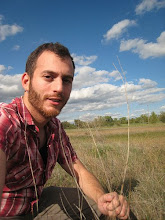DeForest Park's 26 acres are mostly developed,although the southern end of the park has a nature trail that goes through riparian forest, woodlands, and wetlands. Although the developed part of the park is well maintained, this natural area suffers from litter, vandalism, and homeless encampments. As with any of the parks in this guide I would recommend strongly exploring this park with a friend, rather than on your own.
That said, there are some unusual habitats to see at DeForest Park which are scarce in the rest of the city. The main trail of the park winds through a riparian forest that contains cottonwoods, coast live oaks, willows, and nonnative pepper trees. Small spurs from the main trail take you closer to wetlands that run along the levee of the LA River.
Riparian zones are stream-side habitats. Typically, riparian zones are dense forests made up of trees that can tolerate the special challenges of living next to a stream. These challenges incude saturated, oxygen-poor soils; abrasion from suspended rocks during floods; and a rapidly changing, dynamic landscape (with frequent erosion and burial in sediment). Many riparian trees, such as California bay trees, adapt to this tumultuous landscape by resprouting easily when they get knocked over.
Freemont cottonwood trees (Populus freemontii) have distinctive heart-shaped leaves and thick, light-gray bark. These trees reach impressive stature (up to ~70 feet tall) and in our region are often the largest native trees around.
At DeForest Park, the riparian forest is composed largely of Freemont cottonwoods (Populus fremontii), willows (Salix spp.) as well as many nonnative trees, such as pepper trees (Schinus spp). The growth is dense, and much loved by the abundant birds, squirrels, and lizards of the park.
Beneath the cottonwoods are thickly grown wetlands, full of bulrushes, sedges, and cattials. Many wetland birds nest in these tall plants and eat their seeds.
Rushes, unlike grasses, have round, hollow stems. The flower structure is also different, but it can be hard to tell without a magnifying lense.
Sedges are another grass-like plant common in wetlands. In California, most are low-growing species. They can be distinguished from grasses by their triangular, or edged leaves.
Elegant willow weeds (Polygonum lapathifolium)grow in saturated soils. Other flowering plants may be common at certain times of year.
At the south end of the park (near the Long Beach Boulevard bridge), the riparian forest gives way to an open, weedy grassland, although the wetlands continue down here as well. There are plenty of wildflowers in this area, as well as birds, so be sure to pay a visit if you make it down to the park. Although the plants are mostly nonnative, there are a few interesting native plants, and plenty of beauties.
[Need ID]
Tolguacha, or false jimson weed (Datura wrightii), has huge, trumpet-like flowers and soft, velvety silver-green leaves. Indigenous people used it for medicinal purposes, and to make a psychoactive drug.
The fruit of tolguacha (Datura wrightii) has an unusual spikey skin. The dried flower usually remains attached.
California croton (Croton californica) is an attractive silvery-gray shrub.
The small flowers of croton are inconspicuous, but very attractive to bees and other insects.
The castor bean (Ricinus communis) is a weedy shrub from Africa. The flower stalk has male flowers at the bottom, and female flowers (mature fruits in this photo) and the top.
Morning glory, or bindweed (Convolvulus arvensis) grows up the stalks of a bulrush. Unlike the native morning glory (genus Calystegia), this flower has small bracts a few inches below the flower.
Common thistle (Cirsium vulgare), a very widspread nonnative weed.
There is abundant wildlife to observe in this park. Keep your eyes and ears pealed!
A mourning dove (Zenaida macroura) gathers nesting material.
Western fence lizards (Sceloporus occidentalis) are pretty common in this park, and coastal whiptails (Aspidoscelis tigris stejnegeri) as well. On the trail, I encountered a very large snake skin in perfect condition:
The previous owner was probably a California kingsnake (Lampropeltis getula californiae). This specimen was huge--over 6 feet long! However, few of this species ever get even half that size. The adults have bold black and white patterning. Although a harassed snake may bite a person, it is non-venemous and is not considered dangerous. It is a constrictor, strangling its prey before eating it. Kingsnakes eat rodents, lizards, and even other snakes! In fact, rattlesnakes are a preferred prey item, and kingsnakes are thought to be immune to their venom.
Coastal Los Angeles and Orange County is home to a unique type of kingsnake, called the "Long Beach morph" or the "grease king." These types (morphs) have complicated patterns, with blotches of cream on a dark background (as opposed to the stripes or rings more typical of this subspecies). Herpetologists have found evidence for a genetic basis for the unusual pattern, suggesting that Long Beach is home to a distinct population of this species. Given the extensive development of this morph's home range, it is not surprisng that it is now extremely rare in the wild. Future research may determine if this morph is genetically distinct to warrant protection as an endangered species.

No comments:
Post a Comment